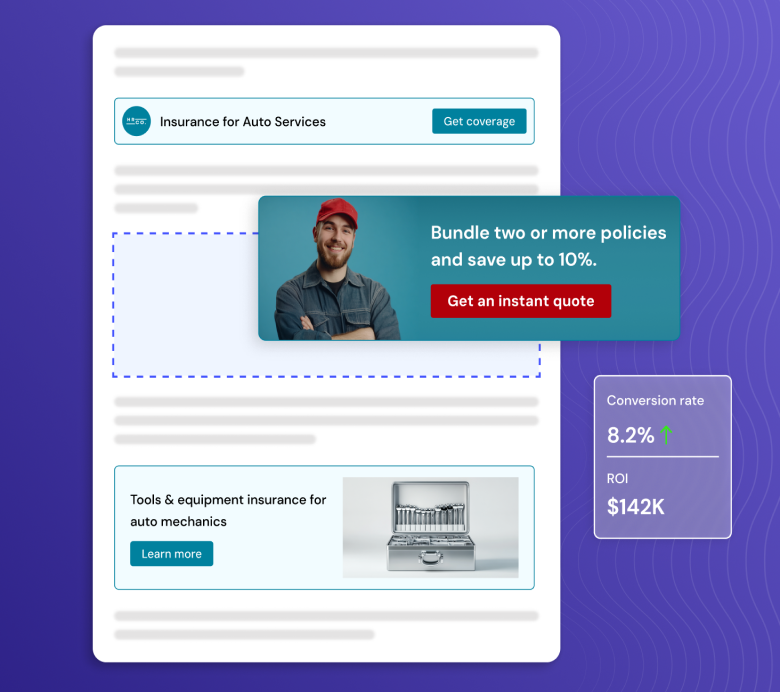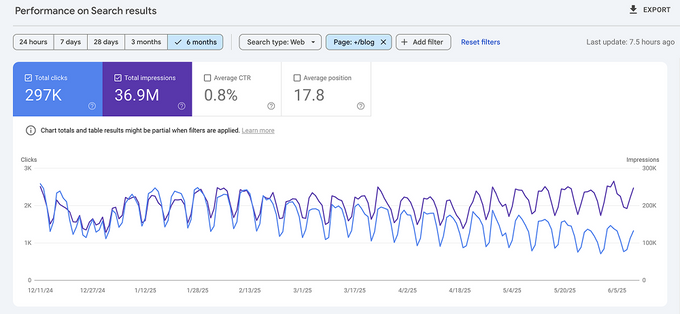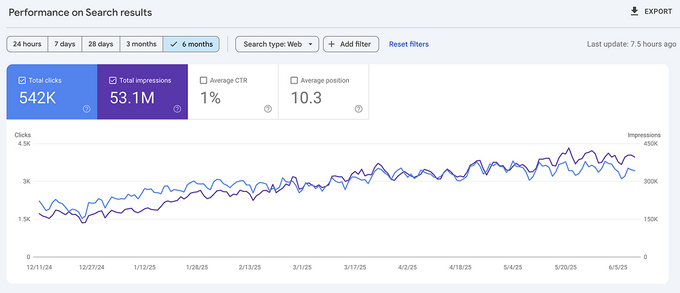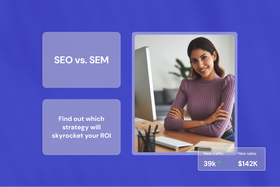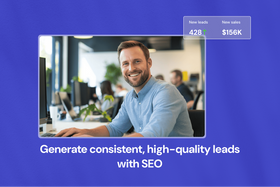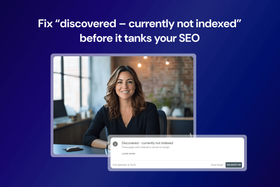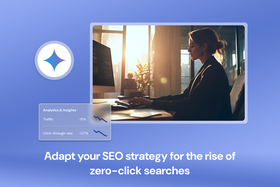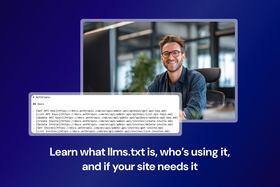AI overviews: An analysis of B2B vs. B2C search performance
Clicks are down for B2B SaaS and up for B2C e-commerce because of AI Overviews, according to our client data. Find out what’s driving this shift and how to adapt.
Updated August 19, 2025
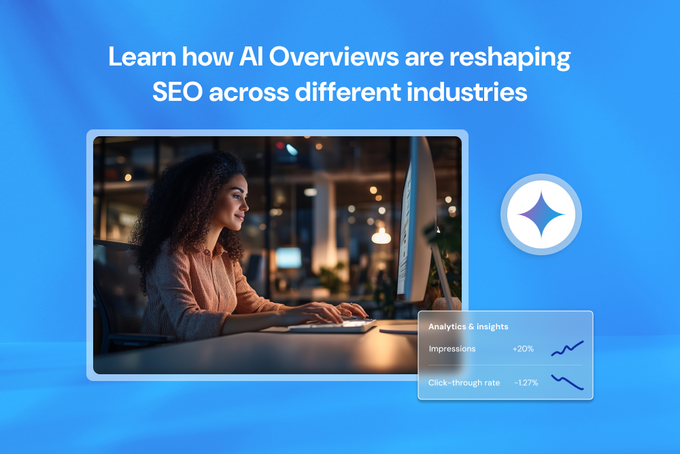
The SEO landscape is constantly shifting, but few developments have caused as much discussion (and distress) lately as Google's AI Overviews. According to a recent Datos and SparkToro report, organic clicks are down, and zero-click searches are rising—an increasingly pressing concern for many of us.
So, over the past few months, we’ve been closely monitoring how AI Overviews affect organic performance across a range of client websites.
What we’ve found is a growing divide between B2B SaaS and B2C e-commerce. Both are seeing their content surfaced in AI Overviews, but the downstream effects on clicks, engagement, and conversions couldn’t be more different.
While some brands are benefiting from increased visibility, others are watching their traffic flatten or decline despite holding strong positions in search.
Let’s break down what’s happening and what it means for your strategy.
Key takeaways
- Overall, AI Overviews have led to a rise in impressions but also a sharp increase in zero-click searches.
- B2B SaaS saw the sharpest drop in clicks as AI Overviews replace top-of-the-funnel content.
- B2C e-commerce sites generally maintained or improved performance, thanks to click-dependent transactional queries.
- B2B SaaS sites must focus on unique insights, mid-to-lower funnel content, and optimizing for citation and brand authority, even if direct clicks decline.
- B2C e-commerce sites should leverage AI Overviews by providing excellent product data, rich visual content, and clear internal linking to drive qualified transactional clicks.
Impact of AI Overviews from late Feb-May
April 2025 saw a broader rollout of AI Overviews. Since then, many of our clients, even those who usually dominate the first SERP, have experienced a spike in impressions but a drop in clicks. In other words, visibility hasn’t gone away, but traffic has become harder to earn.
The most significant declines were concentrated in the B2B SaaS space (see example below). These websites had strong SEO foundations but were especially vulnerable to top-of-the-funnel cannibalization by AI Overviews.
Not all industries felt the effects, however.
B2C e-commerce brands remained somewhat unaffected during this period. In fact, we observed steady or improved performance across several clients in this industry.
Let's explore why this may be, starting with B2B SaaS.
READ MORE: Should you change your SEO strategy because of AI?
Why B2B SaaS sites may be more heavily impacted by AI Overviews
The nature of B2B SaaS, particularly at the top of the funnel, makes it especially vulnerable to the zero-click behavior driven by AI Overviews.
Based on our research, the main reasons include:
Dominance of informational queries
B2B SaaS often relies heavily on informational content that targets queries like "what is CRM?", "how does cloud computing work?", and "benefits of marketing automation software."
These are exactly the kinds of questions AI Overviews are built to answer directly on the SERP. In many cases, that brief summary is enough for users to move on without ever clicking through, even if the original content offers more depth.
Even complex technical concepts are now condensed into quick, digestible explanations. This makes diving into a detailed whitepaper or guide less necessary in the eyes of the user.
Longer, more nuanced sales cycles
B2B buying journeys are typically longer and more complex. While lower-funnel stages (demos, pricing, specific feature comparisons) still require more direct engagement, the zero-click effect is most pronounced at the very top of the funnel (awareness and consideration stages).
If a B2B SaaS website's SEO strategy is focused on attracting traffic at this early stage, they will see a significant drop in clicks, even if their content is featured in AI Overviews.
Nature of the content
Much of the content in this space is designed to explain, educate, or solve problems. If it lacks specificity or proprietary insight, it’s easily summarized and absorbed by AI.
On the flip side, content with unique insights, proprietary data, and real use cases is harder for AI to replicate and may still drive clicks.
» Create better content with our top-of-the-funnel marketing tips.
Trust and fact-checking
While studies suggest that 90% of B2B buyers click through to verify information, the AI Overview often answers their early-stage query well enough to delay or reduce that click. The motivation to fact-check typically arises later in the buyer journey when decisions are more critical, not during top-of-funnel research.
Note: In one case, a B2C website’s ongoing decline in site health coincided with the AI Overview rollout. What could’ve been a chance to gain visibility and build topical authority instead resulted in Google demoting them further down the SERP. This shows that site health remains essential for both SEO and visibility in AI Overviews.
» Need help optimizing for AI Overviews? Talk to an SEO expert.
Why B2C e-commerce sites are seeing a positive impact
The nature of B2C e-commerce lends itself to a more positive interaction with AI Overviews. This includes their blog content across all funnel stages.
Here's why:
Transactional intent still requires clicks
B2C users are often ready to buy, and AI Overviews can’t complete a transaction (at least not yet). Even if an AI Overview summarizes a product category or buying guide, users still need to visit the site to browse variations, check stock, read full reviews, and add products to cart.
Direct links from AI Overviews drive qualified traffic
For commercial queries, Google’s AI Overviews often include product images, pricing, and links that send users directly to relevant product pages. These are highly qualified clicks with a stronger chance of conversion.
» Boost conversions with our e-commerce CRO tips.
Blog content supports the user journey
Top- and mid-funnel blog content often leads users to specific product or category pages. When an AI Overview summarizes a blog (e.g., “best protein powders” or "top 5 smartwatches"), users still need to click through to see detailed comparisons, product specs, and purchase options. In these cases, the AI Overview acts as a discovery and filtering tool that helps funnel users into conversion paths.
Visuals and reviews are a crucial part of the purchase decision
B2C e-commerce relies heavily on product images, videos, and detailed specifications. AI Overviews can list features, but they can't replace interactive product browsing experiences or the value of detailed user reviews. Similarly, blog posts with visual guides, tutorials, and side-by-side comparisons remain essential because they offer the depth AI can’t match.
READ MORE: 9 content marketing strategies for e-commerce
Local search and immediate needs
Many B2C purchases are influenced by local availability. AI Overviews can integrate local inventory, "near me" results, and store hours, making it easier for users to find a product locally and then click through for directions or to check stock.
Brand discoverability through blog authority
Well-optimized B2C blog content can influence how brands are presented in AI Overviews. If a website is cited as a top resource, it may drive branded searches or direct clicks to the homepage. Strong blog authority can contribute to brand visibility and homepage traffic.
In short: For B2C e-commerce, AI Overviews aren't necessarily "stealing" the entire user journey. Instead, they play a role in filtering, guiding, and pre-qualifying users. So, when users do click, they’re already lower in the sales funnel—which potentially leads to more qualified traffic and better conversions.
» Book a call to get an SEO strategy built to thrive in the age of AI search.
How to optimize your SEO strategy for AI Overviews
AI Overviews are changing the rules of engagement on the SERP. Brands need highly nuanced, sector-specific SEO strategies that align with how Google delivers and summarizes information today.
» Find out if there's a difference between GEO, AIO, and LLMO.
For B2B SaaS websites
- Re-evaluate top-of-the-funnel content: Focus on creating content that answers questions comprehensively but also encourages deeper engagement. This could mean including unique proprietary data, thought leadership, or specific case studies in your content.
- Shift focus to mid-to-lower funnel: Double down on SEO for commercial queries, comparisons, pricing, and use cases where direct engagement is essential.
- Optimize for citation: Even if direct clicks drop, being cited in an AI Overview is valuable for brand visibility and authority. Ensure your content is highly accurate, authoritative, and structured for AI summarization (clear headings, bullet points, direct answers).
- Measure influence beyond clicks: Start tracking mentions or citations in AI Overviews as part of your SEO KPIs.
READ MORE: Generative engine optimization: What it is & how to do it
For B2C e-commerce websites
- Optimize product data: Maximize the use of structured data (Schema.org for products, reviews, availability) to help AI Overviews showcase your products effectively.
- Invest in rich product content & visuals: Use high-quality images and videos, detailed descriptions, and robust customer review sections on product pages and within blog content. This is what drives clicks from AI Overviews.
- Leverage local SEO: For businesses with physical stores, ensure your Google Business Profiles are updated to leverage local search features in AI Overviews.
- Build bottom-of-the-funnel content: Create strong, data-backed comparison guides or "best [product category]" pages. These are highly valuable for users in the consideration stage, can be favored by AI Overviews, and lead to direct product clicks.
- Develop a clear internal linking strategy: Ensure your blog content effectively links to relevant product pages to guide users toward conversion.
SEE ALSO: Are llms.txt files the missing link in AI-powered SEO?
Adapt today to stay competitive tomorrow
AI Overviews aren't a universal threat, and they're not killing SEO. They're a call for smarter, more tailored SEO strategies.
Understanding how this shift affects your specific niche, funnel, audience, and goals is the first step to navigating—and benefiting from—the new search landscape.
» Chat with us about how to optimize your strategy for AI-powered search.
